|
|
Updated as per personal communication with Ezequiel Bustos (Aguas Blancas, Salta, Argentina, 405m); December 2009
Updated as per personal communication with Larry Valentine (Itanhandu, Minas Gerais, Brazil, larva on Plumeria, November); December 2009
Updated as per personal communication with Gregory Nielsen (Vallavicentio, Meta, Colombia); February 6, 2011
Updated as per "A Hawk Moths fauna of southern Maranhão state, Brazil, ... "; NEVA: Jahrgang 34 Heft 3 November 2013; via Jean Haxaire; April 5, 2014
Updated as per personal communication with Ilse Knijn (Aruba); April 30, 2015
|
Pseudosphinx tetrio
The Tetrio Sphinx Moth
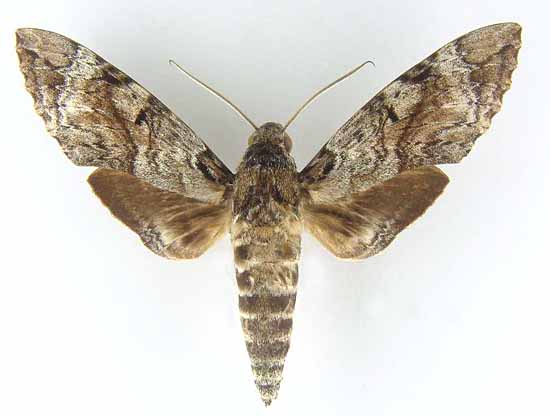
Pseudosphinx tetrio male courtesy of Vernon A. Brou.
This site has been created by
Bill Oehlke at oehlkew@islandtelecom.com
Comments, suggestions and/or additional information are welcomed by Bill.
TAXONOMY:
Family: Sphingidae, Latreille, 1802
Subfamily: Macroglossinae, Harris, 1839
Tribe: Dilophonotini, Burmeister, 1878
Genus: Pseudosphinx Burmeister, 1855 ...........
Species: tetrio Linnaeus, 1771
|
MIDI MUSIC
.....It's a Wonderful World.....
copyright C. Odenkirk
ON.OFF
<bgsound src="world.mid" LOOP=FOREVER>
|
DISTRIBUTION:
The Tetrio Sphinx Moth, Pseudosphinx tetrio (wingspan: 5 - 5 1/2 inches (12.7 - 14 cm) females
larger than males), flies throughout tropical and subtropical American lowlands. It is very common in Guadeloupe and Martinique,
but poorly attracted by light. Generally the moth is seen from southern Brazil: Mato Grosso; Minas Gerais (LV); southern Maranhao;
Argentina: Salta, Tucuman; etc.,
north to Colombia (GN); and through Central America, Mexico, and the West
Indies to south Florida, southern Mississippi, Texas, and southern
Arizona. Ilse Knijn confirms their presence in Aruba.
Pseudosphinx tetrio, Sept. 7, 2002, 2:06 AM in
Yasuni, Ecuador, by Steve Graser. |
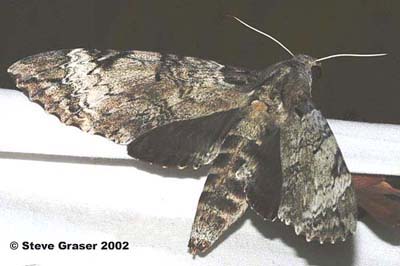
|
Pseudosphinx tetrio has been taken as far north as Nebraska and Pennsylvania.
Alex (January 8, 2005) writes, "Thank you for your website which includes Pseudosphinx tetrio page. I live in Montserrat
(island in the Caribbean Sea, southeast of Puerto Rico) and wanted infomation about the huge caterpillars in the plumeria tree."
The upperside of the forewing is dark brown with a dark spot at the base of the costa and blurry gray and white markings. The upperside
of the hindwing is dark brown with white along the inner margin, and the lower half of the outer margin.
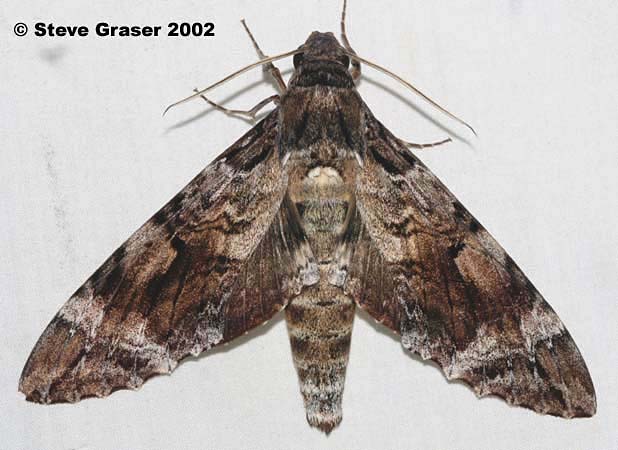
Pseudosphinx tetrio, Sept. 7, 2002, 2:06 AM in
Yasuni, Ecuador, by Steve Graser.
Sphinx hasdrubal Cramer, 1780, Surinam, is same as
tetrio.
obscura Butler, 1877, Honduras, is same as tetrio.
albina Gehlen, 1941, Cuba, is synonym for tetrio.
FLIGHT TIMES:
In Costa Rica there are records for all
months except March and December.
There are several flights from
March-September in Florida. I occasionally get asked to identify
larvae found in Florida in December or even January.
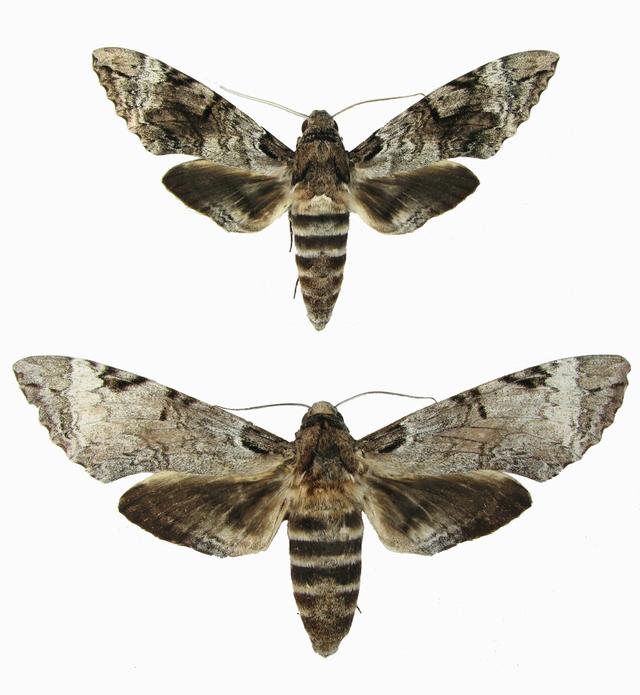
Pseudosphinx tetrio pair, male (top, 116mm, January 10, 2011);
female (bottom, 157mm, November 28, 2010),
both from Villavicentio, Km 13 via Acacias, Meta, Colombia,
04°03’55.0 N 073°41’87.0 W,
500m, courtesy of Gregory Nielsen.
ECLOSION:
Moths eclose from pupae under leaf litter or
in subterranean chambers.
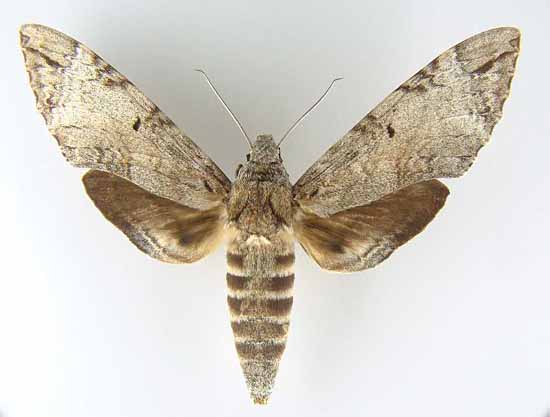
Pseudosphinx tetrio female courtesy of Vernon A. Brou.
SCENTING AND MATING:
Females call in the males with a
pheromone released from a gland at the tip of the
abdomen.
Adults nectar from flowers including rosy periwinkle
(Vinca rosea).
EGGS, LARVAE, PUPAE:
Females lay eggs in clusters on leaves of various hosts.
Larvae feed on Allamanda cathartica and Frangipani (Plumieria rubra)
and probably other members of the
Dogbane family: Apocynaceae. The brightly coloured caterpillar is easy to find in gardens.
The larva feeding on a tree of
Himatanthus. This tree produces a white, toxic latex which
is incorporated into the tissues of the caterpillar without harming it.
The toxins in the caterpillar, however, are toxic to
would-be-predators. Larvae with red-yellow-black
colours usually carry toxins and are left alone by birds.
|
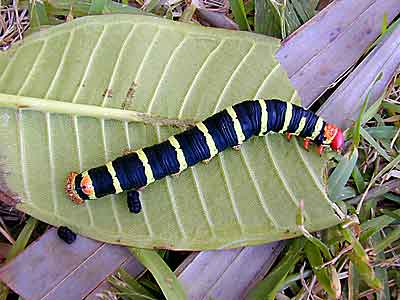 |
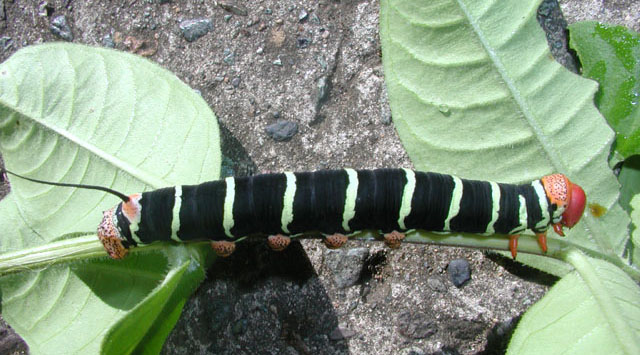
Pseudosphinx tetrio, Puerto Rico, courtesy of Brian M. Irish.
Brian writes, "I found many of them devouring a purple allamanda and
also on a large tree (Bombaceae) on the USDA Tropical Agricultural
Research Station grounds in Mayaguez, PR."
Brian M. Irish, Horticulturist/Genetecist, Tropical Agricultural
Research Station, Mayaguez, PR 00680
These caterpillars defoliate the Frangipani tree
(Plumeria spp.) They generally start at the tip of a leaf and work
back. The caterpillar is velvety black with yellow rings and an orange head.
They can get up to six inches long and are awesome to see.
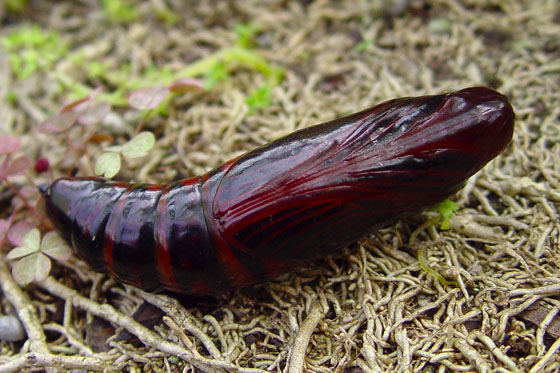
Pseudosphinx tetrio pupa, Boca Raton, Florida,
courtesy of Alan Chin-Lee.
Ruby Rodriguez reports them defoliating Plumeria cujete
in Puerto Rico.
Visit Pseudosphinx tetrio larva on Plumeria, Itanhandu, Minas Gerais, Brazil, November 2009, courtesy of Larry Valentine.
Return to U. S. A. Table
Return to Sphingidae Index
Return to Dilophonotini Tribe







